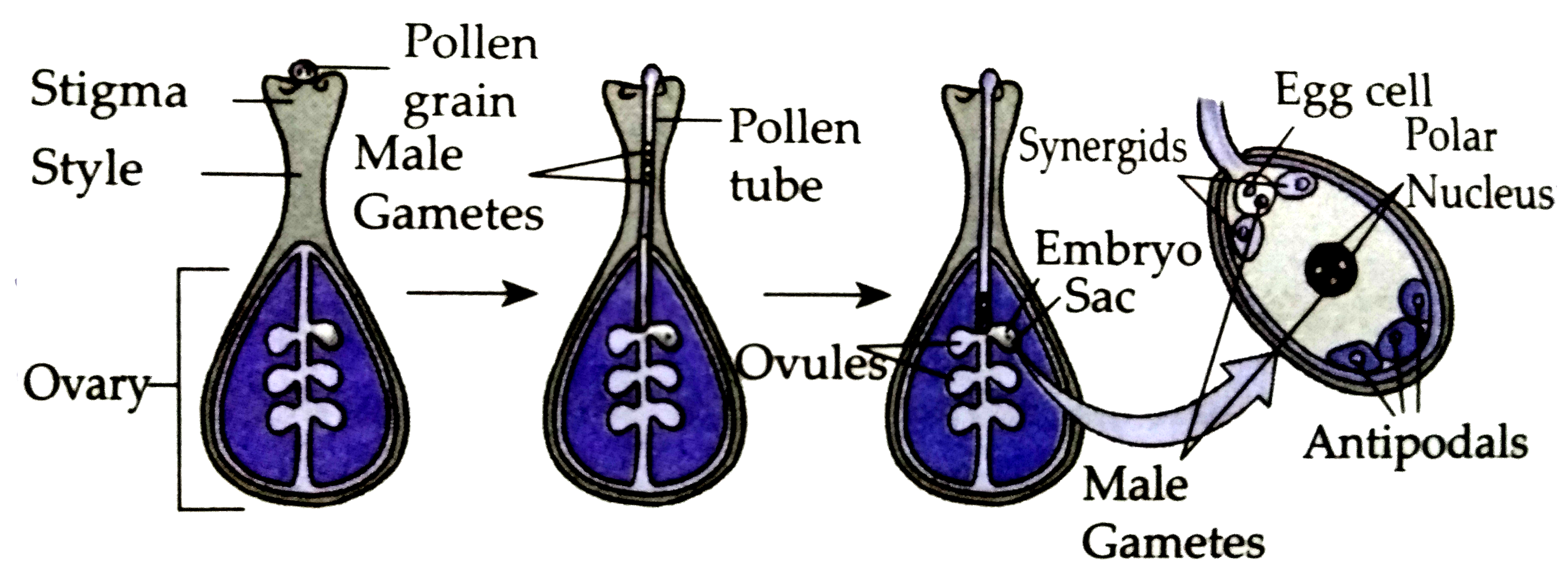Sexual reproduction Solution in Tamil

(i) A flower is the site of sexual reproduction in plants .
(ii) It consists of four floral whorls calyx, corolla androceium and gynoecium .
(iii) Androecium and gynoecium are called as essential whorls.
(iv) Calyx and corolla are called as accessory whorls.
(v) Androecium is male whorl and its members are called stamens, will be gynoecium is female whorl and its members are called as carpels.
(vi) Ovary present at the basal end of carpel contains one or many ovules. A hollow style comes up from the ovary.
(vii) Embryo sac is formed in each ovule by meiosis and each embryo sac consists of a haploid egg cell and two haploid polar nuclei.
(viii) Pollen grains are transferred from anther to the stigma. This is called as pollination.
(ix) When pollination occurs a long pollen tube carrying two male gametes is formed.
(x) Pollen tube reaches the embryo sac via style.
(xi) Pollen tube bursts and two male gametes are released in embryo sac. One male gamete unites with egg cell to form zygote. This process is called fertilization.
(xii) The second male gamete unites with two polar nuclei and endosperm is formed. This is called double fertilization.
(xiii) After fertilization ovule develops into seed and ovary into fruit.
(xiv) Seeds fall upon the ground when fruits break up and they germinate in the soil under favourable conditions.
(xv) Zygote develops at the cost of food stored in endosperm of seed and thus a new plantlet is formed. This is called as seed germination.
Topper's Solved these Questions
- LIFE PROCESSES IN LIVING ORGANISM PART-2BOOK - CHETAN PUBLICATIONCHAPTER - LIFE PROCESSES IN LIVING ORGANISM PART-2EXERCISE - Assignment-3 (Answer the following).
3 Videos
- LIFE PROCESSES IN LIVING ORGANISM PART-2BOOK - CHETAN PUBLICATIONCHAPTER - LIFE PROCESSES IN LIVING ORGANISM PART-2EXERCISE - Assignment-3 (Choose and write the correct option ).
2 Videos
- LIFE PROCESSES IN LIVING ORGANISM PART-2BOOK - CHETAN PUBLICATIONCHAPTER - LIFE PROCESSES IN LIVING ORGANISM PART-2EXERCISE - Observe the figure
10 Videos
- INTRODUCTION TO MICROBIOLOGY BOOK - CHETAN PUBLICATIONCHAPTER - INTRODUCTION TO MICROBIOLOGY EXERCISE - Assignment - 7
12 Videos
- LIFE PROCESSES IN LIVING ORGANISMS PART-1BOOK - CHETAN PUBLICATIONCHAPTER - LIFE PROCESSES IN LIVING ORGANISMS PART-1EXERCISE - Assignment-2
11 Videos
Similar Questions
Fill in the blanks .
Implantation of embryo occurs in ..............
View SolutionYeast reproduces by ____________
View Solution
Which method of reproduction is shown in the diagram?
View SolutionAcetic acid is bleached with the help of ……….
View SolutionOur muscle cells perform ………………. Type of respiration during exercise.
View Solutionकायिक जनन एवं लैंगिक जनन में मुख्य अन्तर बताइए ।
View SolutionWhat is sexual reproduction ? Explain the two main processes involved in sexual reproduction.
View SolutionWhat is sexual reproduction ? Explain the two main processes involved in sexual reproduction.
View Solutionलैगिक जनन में निषेचन की क्या भूमिका होती है। पुष्प मे लैंगिक जनन समझाइये।
View Solutionसामान्य लैंगिक जनन का अलैगिक जनन द्वारा प्रतिस्थापन को क्या कहते हैं ?
View SolutionASEXUAL REPRODUCTION | SEXUAL REPRODUCTION
View SolutionCbse Special | Sexual Reproduction | Sexual Reproduction In Flowering Plant | Part 7
View SolutionCbse Special | Sexual Reproduction | Sexual Reproduction In Flowering Plant | Part 8
View SolutionCbse Special | Sexual Reproduction | Sexual Reproduction In Flowering Plant | Part 9
View SolutionSexual Reproduction|Phases of sexual reproduction
View SolutionWhat is sexual reproduction ? Explain the two main processes involved in sexual reproduction.
View Solution
